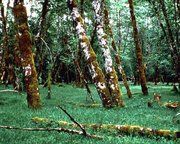Red Alder
|
|
| Red Alder | ||||||||||||||
|---|---|---|---|---|---|---|---|---|---|---|---|---|---|---|
| Missing image Red_alder_leaves.jpg Red alder leaves | ||||||||||||||
| Scientific classification | ||||||||||||||
|
Red Alder (Alnus rubra) is a deciduous tree native to western North America, from southeast Alaska south to central coastal California, nearly always within about 200 km of the Pacific coast, except for an extension 600 km inland across northern Washington into northernmost Idaho. It is the world's largest species of alder, reaching heights of 20-35 m. The official tallest red alder (1979) stands 32 meters tall in Clatsop County, Oregon (USA). The name derives from the bright rusty red color that develops in bruised or scraped bark.
Red alder has ovate leaves 7-15 cm long, with bluntly serrated edges and a distinct point at the end. The leaves turn yellow in the autumn before falling. The bark is mottled, ashy-gray and smooth, often draped with moss. The male flowers are dangling reddish catkins 10-15 cm long in early spring, and female flowers are erect catkins which develop into small, woody, superficially cone-like oval dry fruit 2-3 cm long. The seeds develop between the woody bracts of the 'cones' and are shed in the autumn and winter.

In the northwestern Coast Ranges of the USA, red alder grows on cool and moist slopes; inland and at the southern end of its range (California) it grows mostly along streams and in swamps. It is associated with Douglas-fir Pseudotsuga menziesii, Western Hemlock Tsuga heterophylla, Grand Fir Abies grandis, Western Redcedar Thuja plicata, and Sitka Spruce Picea sitchensis forests. Along streambanks it is commonly associated with willows Salix spp., Red Osier Dogwood Cornus stolonifera, Oregon Ash Fraxinus latifolia and Bigleaf Maple Acer macrophylum. In the high mountains it is replaced by the smaller Sitka Alder Alnus sinuata, and east of the Cascade Mountains by Thinleaf Alder Alnus tenuifolia.
In moist forest areas Red Alder will rapidly cover a former burn or clearcut, temporarily preventing the growth of conifers but also improving soil fertility for future growth of conifers. It is a prolific seed producer, but the seeds require an open area of mineral soil to germinate, and so skid trails and other areas disturbed by logging or fire are ideal seedbeds. Such areas may host several hundred thousand to several million seedlings per hectare in the first year after landscape disturbance (Zavitkovski, J.; Stevens, R. D.; 1972, "Primary productivity of red alder ecosystems", Ecology 53(2): 235-242).
Twigs and buds of alder are only fair browse for wildlife, though deer and elk do browse the twigs in fall and twigs and buds in the winter and spring. Beavers eat the bark. Several finches eat alder seeds, notably Common Redpoll and Pine Siskin, and as do deer mice.
Red alder is also very valuable for playing host to the nitrogen fixing actinomycete Frankia. It is this ability which allows alder to grow in nitrate-poor soils.
Uses and cultivation
A russet dye can be made from a decoction of the bark and was used by Native Americans to dye fishing nets so as to make them less visible underwater.
Red Alder is an important forestry tree. Its rapid growth makes it useful in covering disturbed land, such as mine spoils. Alder leaves, shed in the fall, decay readily to form a nitrogen-enriched humus. It is being considered as a rotation crop to discourage the conifer root pathogen Phellinus weirii (Laminated root rot). The vigorous growth has in the past earned it the designation of a "trash tree" by the timber industry. Herbicide spraying of Red Alder over large areas of coastal Oregon and Washington has resulted in a number of lawsuits claiming it caused health problems, including birth defects and other side effects. The increased value of the wood, combined with a better understanding of the species' benefits to other trees, has largely led to a cessation of this practice.
The wood is not durable in outdoor use but due to its workability and ease of finishing it is increasingly in use for furniture and cabinetry. Historically it has not been considered of high value for timber but it is now becoming one of the western USA's more important hardwoods. Alder wood ranges from white through pinkish to light brown, is relatively soft, and has medium luster. It is easily worked, glues well, and takes a good finish.
The Fender guitar company chose red alder to use in the body of its original Stratocaster® model electric guitar, and it has remained a popular choice for guitars although alder seldom exhibits the spectacular curly or quilted grain seen in some of the maple wood used in instruments.
Red Alders are not commonly planted as ornamental trees but will do well in wet swales or on stream banks. If used domestically they should be planted well away from drainpipes, sewage pipes, and water lines, as the roots may well invade and clog the lines. Red Alders are also famed for growing easily in burned or destroyed land, and are used as "pioneering" or "reclamation" trees.
